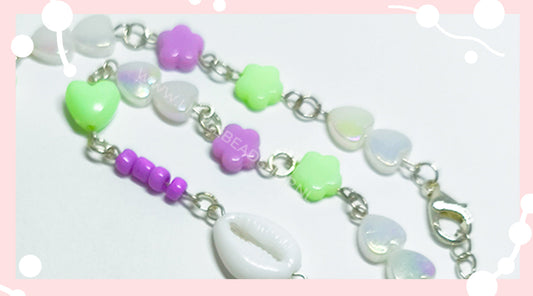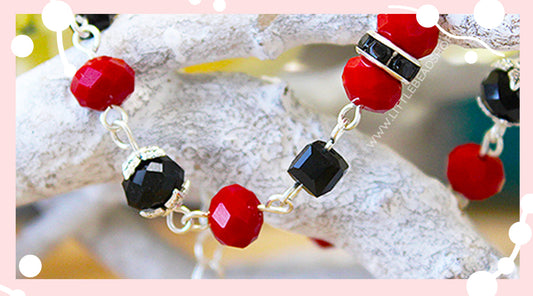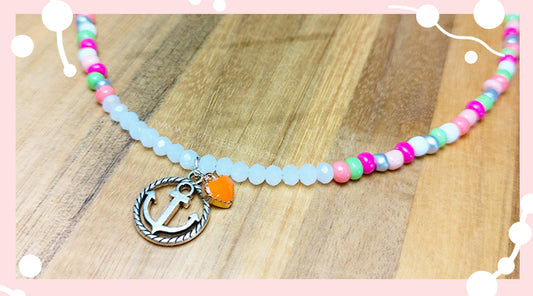
How do you use kettlebells? And what is it?
I'm warning you, this jewelry technique is incredibly addictive! At least, I think so, because it really gives your jewelry a boost! When I started, I wanted to make one piece after another. Until my hands cramped so much from squeezing the jewelry pliers that I had to stop. Oops!
This technique is a bit more challenging than average. But once you've mastered it, you're good to go! You can make both necklaces and bracelets this way, and earrings are also a lot of fun to make with this technique. It's a versatile way to make jewelry and a lot of fun to experiment with.
Linking is the process of connecting pieces of thick wire. You need link pins for this: pieces of wire with a small eyelet on one end. The idea is to thread a bead onto this piece of wire and then create an eyelet on the other end so the bead can't go anywhere. Still with me? Many people I try to explain what linking is look at me as if I'm speaking Chinese. And I do understand them, haha. I'll show you a picture of a linked bracelet, and then you'll know what I mean!

Cool, huh? You can do this technique in two ways. You can attach the head pins directly to each other, or you can use jump rings between them. Instead of attaching the head pin to the next head pin, you attach it to a jump ring. This also gives you the option of making a charm bracelet or necklace, since you can attach a charm or pendant to the jump rings.
Are you convinced yet? I was pretty quick to do so, haha. But I wouldn't make three bracelets at once, like I did. To save your hands. Because it does require some strength!
I'll explain how it works. Below, I'll describe the technique without the rings in between.
What do you need?
– 1 clasp and 1 extension chain
– beads of your choice
Tools required: cutting pliers, flat nose pliers and round nose pliers
Step 1
Thread the bead onto the head pin and grab your round-nose pliers. Use the pliers to pinch the head pin, about a centimeter above the bead. This ensures you have enough space to create an eyelet. The further you grip the pliers, the thicker the pliers become, and therefore the larger your eyelet will be. I usually leave a half-centimeter gap on the pliers so the eyelet is roughly the same size as the existing eyelet on the head pin. (See photo 1)


Step 2
Now, use your round-nose pliers to bend the head pin. Don't tighten it all the way against the bead; always leave a little slack. About 1 to 2 millimeters is sufficient.
Step 3
Now that you've created a nice eye, it's time to turn it back so it looks the same as the existing eye. Turn the eye back a bit, as shown in the photo below.


Step 4
Now it's time to cut off the remaining piece. Do this with wire cutters, as close to the wire stem as possible. Always make sure you hold the piece of metal you're cutting. This way, it can't get in your eyes while you're cutting!
Step 5
Now that you've cut the piece, there may be a gap between the end and the beginning of the eyelet. Therefore, bend the end towards the beginning of the eyelet to ensure a nice, closed eyelet (see photo).


Step 6
Next, open the eye of the next head pin. Always do this by bending the end of the eye toward or away from you, as shown in the photo. If you bend the end to the side, essentially making the eye larger, the metal will be subjected to much more stress and you run the risk of breaking the eye. That would be a shame!
With our jump rings, you do exactly the same thing. Never bend the eyelet to the side, always forward or backward! And preferably as close to the eyelet as possible, but just enough to hang the pin on.
Step 7
Close the loop tightly again. Make sure there's no space between the end and the beginning of the loop. Continue this process throughout the necklace or bracelet until you reach the clasp and the extension chain!


Step 9
Once you've finished chaining the rest of the beads, we'll move on to attaching the clasp and the extension chain. Bend open a jump ring and hook your bracelet and the clasp onto the jump ring. Bend it closed again, making sure the jump rings close securely. This reduces the chance of losing it. Do the same with the extension chain.
Tip!
Do you have jewelry glue or clear nail polish at home? Then you can add a small drop to the ends of the ring. Any space between them will then be sealed by the glue or nail polish. A very small drop is enough. Let this dry completely.
Do you have any questions or are you having trouble? Don't hesitate to send us a message. We're happy to help! You can always send us an email (info@littlebeadshop.nl) or message us on Instagram or Facebook.
And was I right? Is it addictive?! Ugh, I think so!



